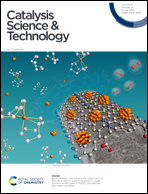Boosting C2 products in electrochemical CO2 reduction over highly dense copper nanoplates†
Abstract
The electrocatalytic transformation of carbon dioxide to higher value hydrocarbons offers opportunities for large-scale, long-term renewable energy storage and lessens carbon emissions. The fabrication of an efficient electrocatalyst with high selectivity for multicarbon (C2) products remains a topic of continuous interest. Here, we report highly dense copper nanoplate catalysts that are highly selective towards C2 product formation (C2H4 and C2H6) with an average partial current density of −9.6 mA cm−2, which is nearly 20 times higher than that of Cu-planar catalysts (−0.5 mA cm−2). The Cu-nanoplate catalyst exhibits 24 times increase in faradaic efficiency (FEC2) compared with the Cu-planar catalyst. The reaction mechanism is studied by in situ Raman and density functional theory (DFT) calculations. The superior selectivity of the Cu-nanoplate catalyst for C2 products originates from the higher surface roughness and abundance of Cu (200) facets. The finding is an important development towards the fabrication of efficient catalysts with exclusively higher selectivity for multicarbon products.



 Please wait while we load your content...
Please wait while we load your content...